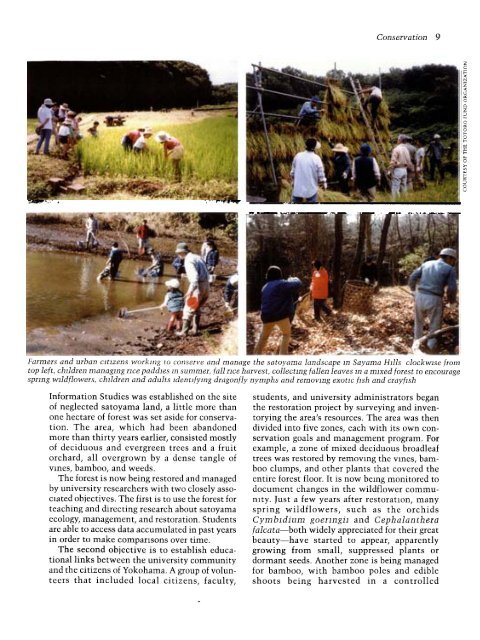Conservation for Satoyama, the Traditional Landscape of ... - Arnoldia
Conservation for Satoyama, the Traditional Landscape of ... - Arnoldia
Conservation for Satoyama, the Traditional Landscape of ... - Arnoldia
Create successful ePaper yourself
Turn your PDF publications into a flip-book with our unique Google optimized e-Paper software.
9<br />
Farmers and urban citizens working to conserve and manage <strong>the</strong> satoyama landscape m Sayama Hills clockwise from<br />
top left, children managmg mce paddles m summer, fall mce harvest, collectmg fallen leaves m a mixed <strong>for</strong>est to encourage<br />
spnng wildflowers, children and adults identlfymg dragonfly nymphs and removmg exotic fish and crayfish<br />
In<strong>for</strong>mation Studies was established on <strong>the</strong> site<br />
a little more than<br />
<strong>of</strong> neglected satoyama land,<br />
one hectare <strong>of</strong> <strong>for</strong>est was set aside <strong>for</strong> conservation.<br />
The area, which had been abandoned<br />
more than thirty years earlier, consisted mostly<br />
<strong>of</strong> deciduous and evergreen trees and a fruit<br />
orchard, all overgrown by a dense tangle <strong>of</strong><br />
vines, bamboo, and weeds.<br />
The <strong>for</strong>est is now being restored and managed<br />
by university researchers with two closely associated<br />
objectives. The first is to use <strong>the</strong> <strong>for</strong>est <strong>for</strong><br />
teaching and directing research about satoyama<br />
ecology, management, and restoration. Students<br />
are able to access data accumulated in past years<br />
in order to make comparisons over time.<br />
The second objective is to establish educational<br />
links between <strong>the</strong> university community<br />
and <strong>the</strong> citizens <strong>of</strong> Yokohama. A group <strong>of</strong> volunteers<br />
that included local citizens, faculty,<br />
students, and university administrators began<br />
<strong>the</strong> restoration project by surveying and inventorying<br />
<strong>the</strong> area’s resources. The area was <strong>the</strong>n<br />
divided into five zones, each with its own conservation<br />
goals and management program. For<br />
a zone <strong>of</strong> mixed deciduous broadleaf<br />
example,<br />
trees was restored by removing <strong>the</strong> vines, bamboo<br />
clumps, and o<strong>the</strong>r plants that covered <strong>the</strong><br />
entire <strong>for</strong>est floor. It is now bemg monitored to<br />
document changes in <strong>the</strong> wildflower community.<br />
Just a few years after restoration, many<br />
spring wildflowers, such as <strong>the</strong> orchids<br />
Cymbidium goeringil and Cephalan<strong>the</strong>ra<br />
falcata-both widely appreciated <strong>for</strong> <strong>the</strong>ir great<br />
beauty-have started to appear, apparently<br />
growing from small, suppressed plants or<br />
dormant seeds. Ano<strong>the</strong>r zone is being managed<br />
<strong>for</strong> bamboo, with bamboo poles and edible<br />
shoots being harvested in a controlled

















